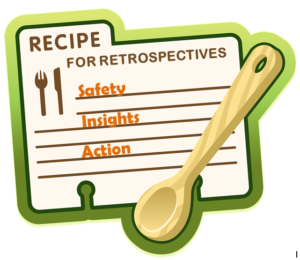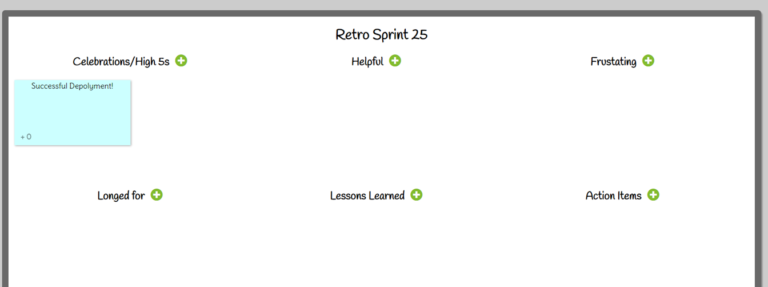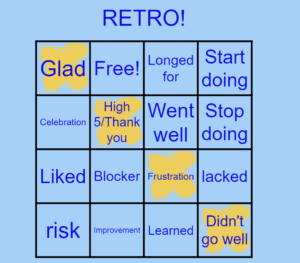Facilitating Engaging and Effective Agile Retrospectives
Retrospectives (aka retros) happens to be the most challenging for facilitators as well as participants. Retros are often thought of as a waste of time, unproductive, lacking in participation, and rarely resulting in positive change.
As a scrum master once told me, it’s like trying to draw water from a rock….
Interestingly, retros also happen to be my favorite of all the agile events. My goal now is to show some ways to achieve the intended value of retros.

Why do we do retrospectives?
The goal of retrospectives is to inspect, learn, adapt, and build continuously improving, high performing teams.
Instead of time wasters, retrospectives can be time savers, as they give the team opportunities to break areas of poor performance and provide opportunities for team maturity.
When do we do retrospectives?
3 Primary Ingredients to a Retrospective

There are 3 key ingredients to an effective and engaging agile retrospectives that I have found and summarized based on personal experience and other agile coaches:
1. Safety
2. Insights
3. Action
Safety

Retros are an intimate event. The teams need the space to talk candidly without concern about throwing their peers under the bus.
Safety #1 – Break down barriers and build trust
These are the people who can join a retrospective;
Agile Team
- Developers/Testers
- Scrum master
- Product owner
Notice managers are not on the list. NO MANAGERS should be present. Retros are a time for the team to safely reflect and come up with their own solutions, it is not a time for managers to facilitate or manage their team. Also, what is brought up in a retrospective should not show up on anyone’s evaluation.
Safety #2 – Ice breakers (engage within 5 minutes)
After years of disliking icebreakers, and considering than as being shallow, compulsory social activities that I didn’t sign up for when I joined a meeting, I have come to learn some value and even psychological science behind them through my experience with retrospectives.
The theory behind ice breakers is, if you can get someone to speak and put their voice out in the atmosphere within the first 5 minutes of a meeting, they are more likely to participate throughout the discussion. It’s fascinating and really does work, try it!
For larger group retros, an easy ice breaker is to start with a poll. It meets a similar goal: pulling people in from the beginning.
Safety #3– The Golden Rule
The Golden Rule of retrospectives, also called the Prime Directive states:
“Regardless of what we discover, we understand and truly believe that everyone did the best job they could, given what they knew at the time, their skills and abilities, the resources available, and the situation at hand.” – Norm Kert. Project Retrospectives: A Handbook for Team Review
I recommend setting the stage with this message for a new team and as a regular reminder for established teams. The environment is to be:
- Non-judgemental.
- Not a time to play the name blame game.
- Focusing on processes and not people and their personalities.
- Remember we are a team, and everyone desires to do a good job.
Safety #4 – Voluntary and anonymous
Use collaborative tools to help preserve anonymity. When anonymous input is available, people will be more open to speak.
Don’t force people to speak. Again, we want to use collaborative tools instead of requiring someone to speak on the spot.
Insights

Insights is the meat of a retrospective. It is where the teams answer questions to help reflect on the previous sprint. If the facilitator is always asking ‘What went well, what didn’t go well, and actions needed’ – then its time to spice things up a bit. Here are some tools and ideas to mix things up.
Insights #1 – Collaborative boards
You can make collaborative boards on Ideaboardz.com. Remember to:
- Make the categories relevant.
- Send out links ahead of time so members can start thinking.
- Send instructions, screenshots whatever you need to do to remove barriers so people can focus on just sharing their thoughts.

Insights #2 – Sailboat
I’ve used the sailboat template this both ways, by looking backward and forward. Forward is challenging the team to think proactively about risks and impediments before going into the next sprint.
This method works well with tools such as Miro and Mural.

Insights #3 – Retro Bingo!
This one I made up. I was inspired by a team member who really liked bingo. It was a way to spice up the retro and have some productive fun.
Bingobaker.com generates a unique bingo card when someone clicks on the link you send out. You call out an item, they click on the item after they share, and whoever gets all in a row, they yell RETRO!

Insights #4 – Mad Sad Glad
This method can be used for teams that had an emotionally driven issue. It helps uncover the root causes of the emotions that are getting in the way of the team’s progress. Anonymity produces the best result with this method.
This method is provided in Miro.

Action

Once all of the ideas are generated, action must happen. Otherwise everyone will feel like the retrospective is a waste of time.
- Add at least 1 action item to team backlog.
- Always remember to review previous action items! Begin each daily scrum going over the progress of each action item.
- If problems involve other teams or managers, with the teams permission bring up the issues to the relevant teams and managers to help resolve external impediments.
Additional resources
Agile Retrospectives. Ester Derby & Diana Larsen. (2006). This is a small book with ~150 pages with tons of tips and ideas it is an excellent foundation for retrospectives.
Remember the 3 primary ingredients to an effective and engaging agile retrospective: safety, insights, and actions!
Written By: D. Roland
